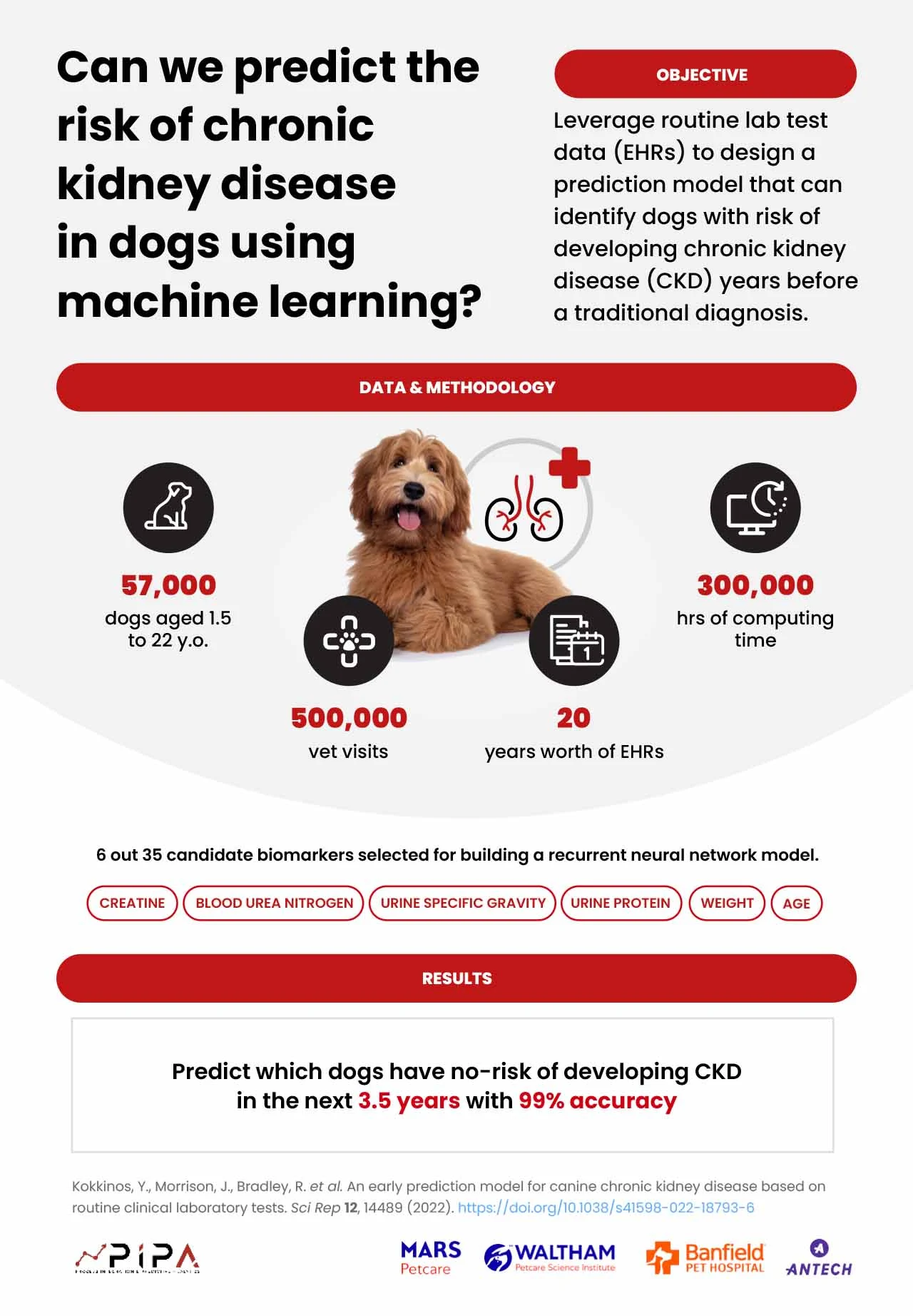Science teams at PIPA and Mars Petcare, following their previous collaboration on building an AI-driven predictor for chronic kidney disease (CKD) in cats (1), set out to build a CKD risk model, this time for dogs. The early prediction model can predict with 84.83% accuracy if a dog will develop CKD in the next twelve months. Read the recent study here.
Predicting the risk of canine chronic kidney disease with Machine Learning
It’s estimated that canine CKD is prevalent in 0,5 to 1% of the dog population in the United States2, but has been shown to approach 25% in some populations studied, including among breeds with a known predisposition (3,4). Identifying signs of the disease during its early stages is difficult and often by the time the symptoms become evident, its impact is already substantial. When it comes to larger breed dogs, CKD often means shorter life expectancy and faster disease progression.
The research team integrated lab test data from more than 57,000 dogs visiting Banfield Pet Hospitals over the course of 20 years, combined with eight optimization steps, a mixture of predictors, and 300,000 hours of computing time in a cluster of 500 computing units to develop an AI-driven model that detects subtle changes in key biomarkers—creatinine, blood urea nitrogen, urine specific gravity, urine protein, weight –along with approximate age—to predict the development of CKD within the next years.
When building the algorithms, researchers initially identified 35 data measurements as candidate biomarkers of CKD. Over time, leveraging machine learning and optimization they narrowed the list to six routine analytes. Much of the research behind this was published in Nature’s Scientific Reports in a study titled, “An early prediction model for canine chronic kidney disease based on routine clinical laboratory tests.”
According to the publication, the model showed some ability to identify dogs at risk of developing CKD within timescales up to 3.5 years before a diagnosis. The model accuracy for which dogs will not go on to develop CKD in the next 3.5 years was above 97% (NPV) in all settings. The model had a 91.4% sensitivity and 97.2% specificity in identifying CKD at the time of diagnosis. For future risk of CKD, the model displayed 68.8% sensitivity at 1 year prior to diagnosis and 97.2% specificity.
Even though the modest PPV limits the model’s use as a stand-alone diagnostic, its high specificity and strong NPV mean the model can be useful and effective in predicting which dogs will not get CKD. A time window that offers great reassurance for concerned pet owners – and especially owners of breeds with conventionally higher prevalence such as the Cocker Spaniel and Border Collie.
Future applications in preventive pet care
The early prediction model is a promising AI-driven approach that in the near future could supplement current proactive veterinary practices that help dogs live long, healthy lives. The recent study reflects the ongoing commitment of Mars Petcare and PIPA to leverage scientific data and artificial intelligence to empower veterinary professionals to recommend timely lifestyle and dietary interventions to support pets’ overall health. Previously, Mars Petcare and PIPA collaborated in a similar study; developing a CKD prediction model for cats with the ability to predict the risk for the disease two years ahead of time compared to traditional diagnosis. RenalTech®, the technology leveraging this model, uses serum and urine diagnostics to predict if cats will develop CKD in the next two years with 95% accuracy.
Using computational science for nutrition innovation
The Mars Advanced Research Institute (MARI) in its mission to spark discoveries that fuel innovation across the organization is collaborating with PIPA to speed up the discovery of plant-based ingredients. Discoveries that could lead to the development of next-gen foods and functional products for people and their beloved pets. R&D teams are using LEAP™, the PIPA AI app to identify links between health states and plants, compounds and other small molecules.

References
- Bradley R, Tagkopoulos I, Kim M, et al. Predicting early risk of chronic kidney disease in cats using routine clinical laboratory tests and machine learning. J Vet Intern Med. 2019;33(6):2644-
- doi:10.1111/jvim.15623
- Joseph W. Bartges, Chronic Kidney Disease in Dogs and Cats, Veterinary Clinics of North America: Small Animal Practice, Volume 42, Issue 4, 2012, https://doi.org/10.1016/j.cvsm.2012.04.008.
- Littman, M. P. Genetic basis for urinary tract diseases. In BSAVA Manual of Canine and Feline Nephrology and Urology, 3rd ed, BSAVA (eds Elliott, J. et al.) 172–184 (2017).


